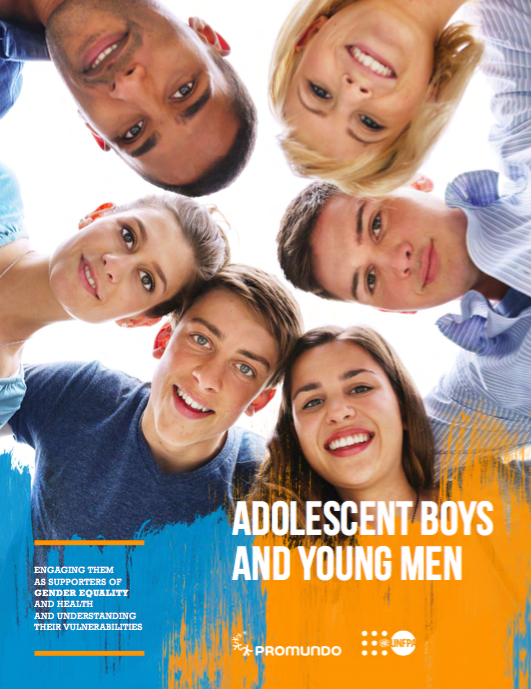- Log in to post comments
New publication by Promundo and UNFPA highlights importance of engaging young men in gender equality and in sexual and reproductive health and rights.
Reaching gender equality must, and has, involved efforts to understand the vulnerabilities and risks that adolescent girls and young women face every day – but how much do we know about the realities of adolescent boys and young men? Promundo and UNFPA launched a new report today, Adolescent Boys and Young Men: Engaging Them as Supporters of Gender Equality and Health and Understanding their Vulnerabilities, that takes a deeper look at the daily lives of adolescent boys and young men around the world, and how they can join the movement towards improved health and gender equality.
Exploring global research, the report reveals boys’ and young men’s specific risks and realities in relation to health in general, sexual and reproductive health in particular, sexuality, media violence, sexual exploitation, and other vulnerabilities. It analyzes the implications of these risks and realities not only for boys, but also on the lives of women and girls.
Adolescence is a key period where individuals of all gender identities form attitudes, opinions and beliefs – about themselves, about their sexuality, and about their place in the world. It is a period when ideas about equality can become ingrained. The report emphasizes that a holistic approach to advancing gender equality and sexual and reproductive health must include both adolescent girls and boys. It highlights the need to engage adolescent boys and young men as allies to achieve gender equality and as supporters of women’s empowerment, as well as the importance of addressing the specific health and social development needs of boys themselves.
Key Findings:
- General Health: Harmful definitions of manhood and masculinity increase young men’s needless vulnerability to premature morbidity and mortality. Young men under 25 are three times more likely than young women to die of a traffic-related injury.
- Sexuality: Many boys, in numerous settings, question traditional sexual “scripts” and report longing for intimate contact and connection more than they do sexual conquest. This may have benefits in the long-run, as men with more gender-equitable attitudes are more likely to report that they are “satisfied” or “very satisfied” with their sexual relationship with their primary partner.
- Sexual and Reproductive Health: Gender norms and sexual scripts place pressure on young men to embody unhealthy versions of masculinity. In many countries, a majority of adolescent males aged 15-19 have engaged in risky, non-marital sexual behavior in the past year.
- Experiences of Sexual Violence: Stereotypical definitions of masculinity that hinder boys’ help-seeking, as well as deep-seated homophobia, make it difficult for boys to speak out against abuse and sexual exploitation. While women and girls experience the majority of sexual violence, some estimates indicate that one in seven boys experiences sexual violence as a child.
- Education: Studies have found that boys feel that asking for help and doing well in school is a “girl thing”; they may feel pressure to drop out of school to earn an income to support the family, and they lack male role models in the classroom. Boys are more likely to repeat a primary grade than girls in 90 of 113 countries where data is available.
- Mental Health: Men are often poor mental health help-seekers, and health systems are less likely to invite them or reach out to them. Poor mental health is among the leading causes of the global burden of disease for adolescents aged 10-19.
- Media: The media – which includes television shows, films, music, and advertisements – reinforces ideas about hyper-masculinity in which men are rewarded for aggression, toughness, and misogyny. In the United States, almost 21 percent of high school students aged 10 to 18 reported having been cyber-bullied in their lifetime.
Building on this data, the report reviews concrete ways to work with adolescent boys and young men on sexual and reproductive health services, comprehensive sexuality education, fatherhood and caregiving, and the elimination of violence against women and girls, as well as how a masculinity lens contributes to understanding youth violence prevention in general.
Some Strategies:
- Talk About Gender: Programs that address gender or power are five times as likely to be effective in achieving improved sexual and reproductive health outcomes.
- Redefine Norms: Comprehensive sexuality education and violence prevention programming in schools or communities can be thought of as a space to redefine gender norms and to question other cross-cutting inequalities, such as those based on ethnicity, social class, or sexual orientation.
- Improve Access to Services: Engage boys in sexual and reproductive health services (e.g., screenings; clinical diagnosis and treatment; and information, education and counseling) as an entry point to question harmful masculinities.
- Implement Comprehensive Sexuality Education: Comprehensive sexuality education is an essential approach to remaking and reinforcing gender-equitable norms in connection to health.
- Harness the Power of Media: The media reinforces ideas about hyper-masculinity in which men are rewarded for aggression, toughness, and misogyny – but it can also be used for positive change.
(Copied from Promundo Website)
